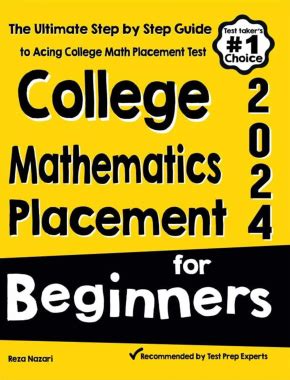Introduction

College math placement tests are a critical gateway to higher education, determining the appropriate math courses you will take in your first year. To succeed on these exams, it’s essential to prepare effectively, and this article will provide you with a comprehensive guide to help you ace them.
Why College Math Placement Tests Matter
According to the National Center for Education Statistics, over 60% of college freshmen must take remedial math courses before they can enroll in college-level math classes. These remedial courses often delay graduation and increase the overall cost of college.
Conversely, strong performance on college math placement tests can:
- Allow you to skip remedial math classes, saving time and money.
- Place you in higher-level math courses, setting you on a path to success in STEM fields.
- Boost your confidence and prepare you for the rigors of college-level mathematics.
Common Mistakes to Avoid
- Underestimating the difficulty: College math placement tests are designed to be challenging and reflect the demands of college-level math. Don’t underestimate their difficulty and prepare thoroughly.
- Cramming at the last minute: Effective preparation takes time and effort. Avoid cramming and start studying well in advance.
- Neglecting basic algebra: Most college math placement tests emphasize basic algebra topics such as factoring, solving equations, and graphing. Make sure to review these concepts thoroughly.
- Ignoring geometry: Geometry is often overlooked, but it can be a significant portion of college math placement tests. Practice problems involving triangles, circles, and other geometric shapes.
- Underutilizing practice tests: Practice tests are invaluable for identifying areas where you need improvement. Take several practice tests and analyze your results to pinpoint your weaknesses.
How to Prepare Step-by-Step
1. Review Prerequisites:
Start by reviewing the prerequisites for the specific placement test you are taking. This will typically include Algebra I, Algebra II, and Geometry.
2. Take Practice Tests:
Utilize practice tests to assess your strengths and weaknesses. The College Board’s SAT Math Level 2 Subject Test and Khan Academy’s Practice Test for College Algebra and Trigonometry are excellent resources.
3. Identify Problem Areas:
After taking practice tests, analyze your results and identify the topics where you struggle. Focus your preparation on these areas.
4. Practice Regularly:
Consistency is key. Set aside time each day to practice math problems. Utilize online resources, textbooks, and workbooks to reinforce concepts.
5. Seek Help When Needed:
Don’t hesitate to seek help from your instructor, a tutor, or a classmate if you encounter difficulties. They can provide guidance and support.
6. Understand the Structure:
Familiarize yourself with the structure of the test, including the number of questions, the time limit, and the types of questions asked. This will help you allocate your time effectively.
7. Stay Calm on Test Day:
Confidence and relaxation are crucial on test day. Get a good night’s sleep, eat a healthy breakfast, and arrive at the test center on time.
Benefits of Preparation
- Increased confidence: Preparation will boost your confidence and reduce test anxiety.
- Improved skills: Studying for the test will sharpen your math skills and prepare you for college-level mathematics.
- Higher test scores: Effective preparation leads to higher test scores, allowing you to place into higher-level math courses.
- Time and cost savings: Skipping remedial math classes can save you time and money.
- Enhanced college success: Strong math skills are essential for success in college, including STEM fields like engineering, medicine, and computer science.
Conclusion
College math placement tests play a crucial role in your academic journey. By following the comprehensive guide outlined in this article, you can maximize your chances of success and set yourself up for a fulfilling college experience. Remember to stay organized, practice regularly, and seek help when needed. With dedication and hard work, you can conquer these tests and position yourself for a bright future in higher education.
Additional Tips
- Use a calculator: Most college math placement tests allow the use of a calculator. Bring a scientific or graphing calculator and make sure it is approved for the test.
- Manage your time: Time management is essential. Allocate a specific amount of time to each section of the test and stick to it.
- Check your work: Before submitting the test, take time to check your answers for errors. Even small mistakes can impact your score.
- Utilize online resources: Khan Academy, Mathway, and Photomath are excellent online resources for practice problems and instant assistance.
Useful Tables
Table 1: Common Topics Covered on College Math Placement Tests
| Topic | Percentage of Test |
|---|---|
| Algebra | 50-60% |
| Geometry | 20-30% |
| Trigonometry | 10-20% |
| Statistics | 5-10% |
Table 2: Average Scores for College Math Placement Tests
| Test | Average Score |
|---|---|
| SAT Math Level 2 Subject Test | 600-700 |
| ACT Mathematics | 24-27 |
| Accuplacer Quantitative Reasoning, Algebra, and Statistics | 220-250 |
Table 3: Time Limits for College Math Placement Tests
| Test | Time Limit |
|---|---|
| SAT Math Level 2 Subject Test | 60 minutes |
| ACT Mathematics | 60 minutes |
| Accuplacer Quantitative Reasoning, Algebra, and Statistics | 120 minutes |
Table 4: Resources for College Math Placement Test Preparation
| Resource | Type |
|---|---|
| Khan Academy | Online practice problems and tutorials |
| Mathway | Math problem solver app |
| Photomath | Math problem solver app with step-by-step explanations |
| The College Board | Practice tests and resources for the SAT |
| American College Testing (ACT) | Practice tests and resources for the ACT |
